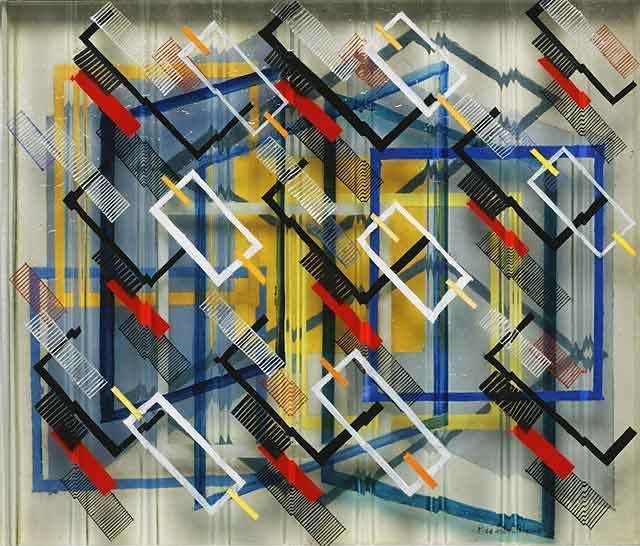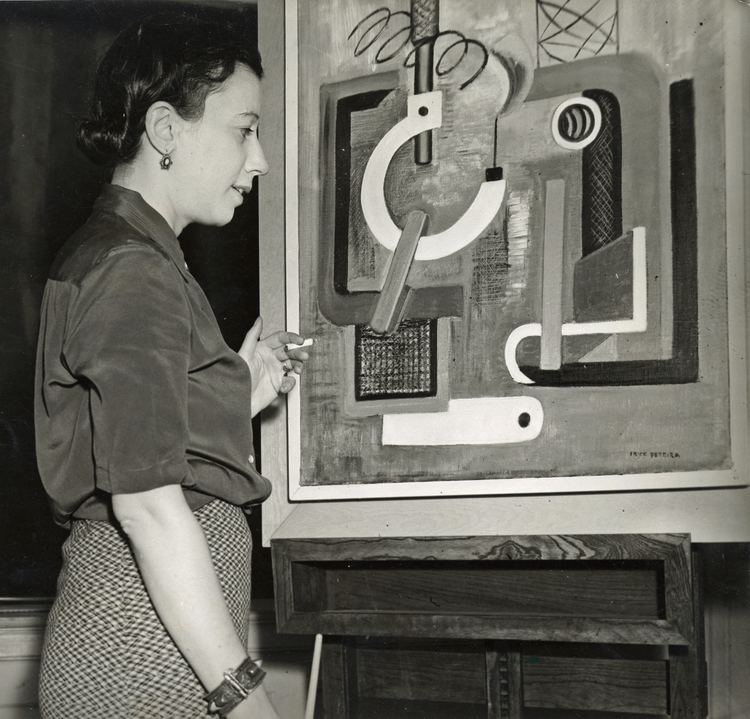Nationality American Role Artist | Name I. Pereira | |
 | ||
Full Name Irene Rice Pereira Known for Painting, writing, poetry, philosophy Artwork Quadrangles in Two Planes, White Lines, Mecca Spouse George Reavey (m. 1950–1959), George Wellington Brown (m. 1942–1950), Humberto Pereira (m. 1929–1938) | ||
Irene Rice Pereira (August 5, 1902 – January 11, 1971) was an American abstract artist, poet, and philosopher who played a significant role in the development of modernism in America. She is known for her work in the Geometric abstraction, Abstract expressionist, and lyrical abstraction genres and her use of the principles of the Bauhaus school. Pereira's paintings and writings were influenced significantly by the complex intellectual currents of the 20th century.
Contents
- Early life
- Beginnings as an artist
- The Design Laboratory
- Mid and later years
- Style
- Personal life
- Writings
- Collections
- Art Works
- References

Early life

Pereira was born Irene Rice on August 5, 1902 in Chelsea, Massachusetts, a suburb of Boston, the eldest of three sisters and one brother. During her career, she often gave her year of birth as 1907, which appears on some legal documents. She spent her childhood in Great Barrington, Massachusetts, where she spent time reading and writing poetry.

After her father died in 1918 she and her family moved to Brooklyn, New York. In 1922 she began working as a stenographer in an accountant's office to help support her family in the wake of her father's death. She briefly attended courses in fashion design at the Traphagen School of Fashion and night courses in literature at New York University, and began taking evening art classes at Manhattan's Washington Irving High School. She immersed herself in the bohemian world of Greenwich Village and had a brief affair with the poet and novelist Maxwell Bodenheim.
Beginnings as an artist

In 1927, she enrolled in night art classes at the Art Students League in New York City. Among her instructors at the Art Students League were Jan Matulka and Richard Lahey. In her 1929 class Matulka provided Pereira with her first exposure to the artistic principles of the European avant-garde that would shape her work; most notably those of the Bauhaus, Cubism, and Constructivism (art). In 1931, she traveled to Europe and North Africa to further her painting studies, attending sessions at the Académie Moderne and studying with Amédée Ozenfant in Paris. She also spent time in Switzerland and Italy.

After returning to New York she studied briefly with Hans Hofmann at the Art Students League. Her friends and colleagues were Burgoyne Diller, Dorothy Dehner, David Smith, Hilla Rebay, Arshile Gorky, John D. Graham, and Frederick Kiesler.
The Design Laboratory
In 1935, Pereira helped found the Design Laboratory, a cooperative school of industrial design established under the auspices of the Works Progress Administration. The curriculum of the Design Laboratory was similar to that of the Bauhaus. All students were required to take a basic course that included an introduction to chemistry, physics, and art materials. Students experimented with materials in laboratories in order to understand their physical properties. There was an emphasis on social considerations, and students were taught the social implications of technological developments alongside classes in art, music, and literature. Pereira taught classes in painting, composition, and design synthesis.
She continued teaching at the Design Laboratory when it lost its financial support from the Works Progress Administration on June 27 of 1937. On July 1, 1937 the Design Laboratory became part of the FAECT School, located at 114 E. 16th St. New York. When Classes resumed on September 27 of 1937 the school was known as The Laboratory School of Industrial Design. She resigned her position in October 1939.
Mid and later years
Pereira painted throughout her life. Her paintings first gained recognition in the early 1930s, when she exhibited at the ACA Galleries and the Whitney Museum of American Art in New York. With the showcase at the Whitney, she became one of the first women (along with Loren MacIver and Georgia O'Keeffe) to be given a retrospective at a major New York museum. In the late 1930s, she started to move away from realistic work toward abstraction and experimented with painting on layered glass.In 1943, Pereira was included in Peggy Guggenheim's show Exhibition by 31 Women at the Art of This Century gallery in New York. In 1946, Pereira was included in the Museum of Modern Art's exhibition 1946:Fourteen Americans.
During the latter part of her career, Pereira rejected abstract expressionism and experienced difficulties with gallery owners and museum directors. She believed that art and literature were being swallowed up in "a chaotic void of mindlessness." Eventually, she left New York permanently and moved to Spain. She died of emphysema on January 11, 1971 in Marbella, Spain.
Style
Pereira was interested in exploring the role of the artist in society, believing artists to be on a par with industrialists. She created "machine paintings" that incorporated images of technological components, including ship's ventilators, generators, and funnels, as well as hinges, levers, and gears. Boat Composite from 1932, in the collection of the Whitney Museum of American Art is an example of her "machine paintings".
Pereira began to explore abstraction in the late 1930s and her work included fewer references to machines. She became known for the geometric and rectilinear paintings created during this period. Abstraction from 1940, in the collection of the Honolulu Museum of Art, demonstrates her approach to geometric abstraction. She was interested in finding a way to bring light into her work, and began to incorporate materials such as glass, plastic, gold leaf, and other reflective materials into her paintings. She experimented with radium paint, layers of painted glass, and paint on parchment.
In a 1950 statement, she said "My philosophy is the reality of light and space; an ever flowing--never-ceasing--continuity, unfettered by man made machinery, weight and external likenesses. I use geometric symbols because they represent structural essences and contain infinite possibilities of change and dynamics."
Pereira signed her work as "I. Rice Pereira," which led to many people thinking she was a man.
Cataloging of her works can be problematic as she frequently left works untitled and reused titles.
Personal life
Irene Rice Pereira's first husband was the commercial artist Humberto Pereira, a painter, whom she married in 1929. They divorced in 1938 and in 1941, she married George Wellington Brown, a naval architect who shared her interest in applying new materials to art. When this marriage ended in divorce, she married the Irish poet George Reavey in 1950; that marriage, too, ended in divorce in 1959.
Writings
Pereira worked prolifically as a writer, but she never received the same acclaim in this area as she did in painting. She published her first article in 1944, titled An Abstract Painter on Abstract Art. Her writings included topics such as structure, time, optics, and space. Her self-published book The Lapis discussed her dreams about the philosopher's stone. The original manuscript of The Lapis, 1954-1955, is housed at Houghton Library, Harvard University, and was a gift of Mrs. Irene Rice Pereira in 1958. The Lapis was republished in 1957 for a limited 1000 book run. She also wrote poetry and in 1968 she became an Honorary Poet Laureate of the United Poets' Laureate International, which is headquartered in the Philippines. She published her last work, The Poetic of the Form on Space, Light and the Infinite in 1969.
Published writings by Pereira include: Light and the New Reality (1951), The Transformation of Nothing (1952), The Paradox of Space (1952), The Nature of Space (1956), The Lapis (1957), Crystal of the Rose (1959), Space, Light and the Infinite (1961), The Simultaneous 'Ever-Coming To Be' (1961), The Infinite Versus the Finite (1962), The Transcendental Formal Logic of the Infinite (1966), and The Poetics of the Form of Space, Light and the Infinite (1968).
Collections
The Boca Raton Museum of Art, the Brooklyn Museum, the Hirshhorn Museum and Sculpture Garden, the Honolulu Museum of Art, the National Gallery of Art (Washington D.C.), The Phillips Collection (Washington D.C.), the Smithsonian American Art Museum, the University of Iowa Museum of Art, the Baltimore Museum of Art (Baltimore, Maryland), the Metropolitan Museum of Art (New York City), the Addison Gallery of American Art (Andover, Massachusetts), the Museum of Modern Art (New York City), the Dallas Museum of Art (Dallas, Texas), and the Whitney Museum of American Art (New York City) are among the public collections holding work by I. Rice Pereira.
Art Works
Listed Chronologically:
Plates from The Lapis, 1954.
